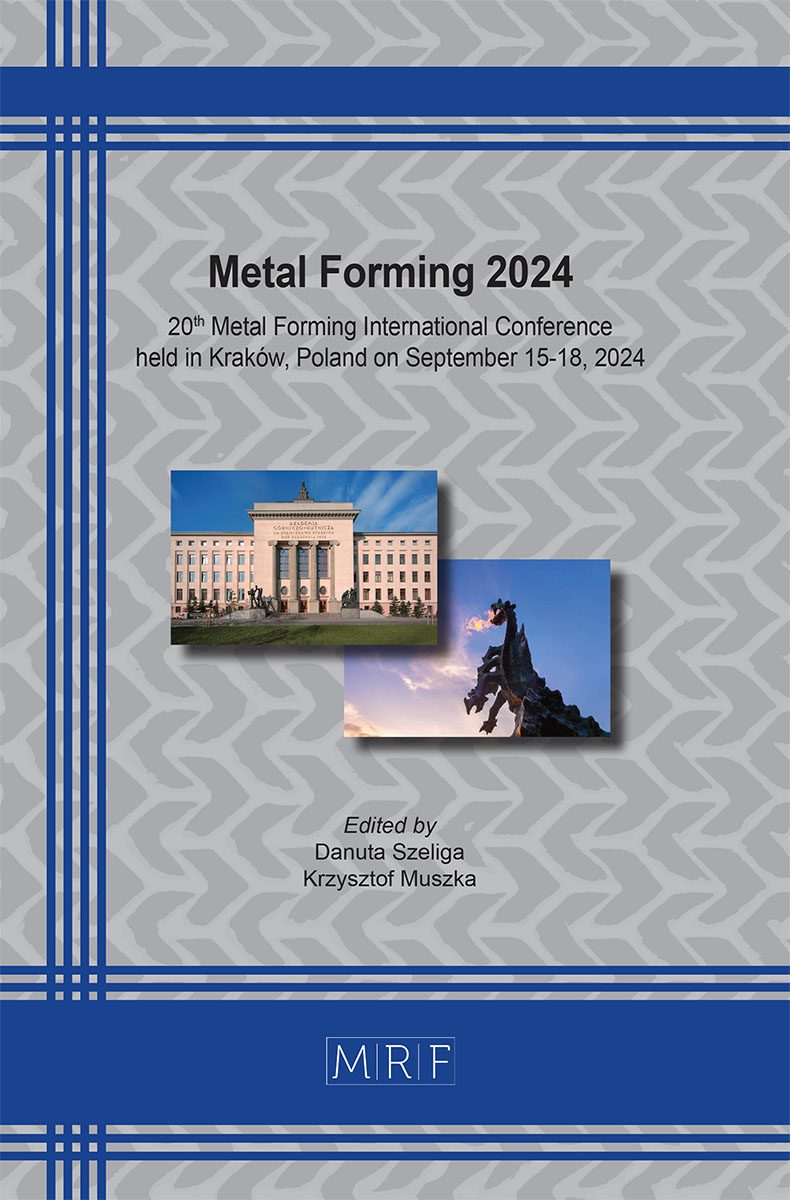–
α’-martensite grading techniques in reverse flow forming of AISI 304L
ARIAN Bahman, HOMBERG Werner, KERSTING Lukas, TRÄCHTLER Ansgar, ROZO VASQUEZ Julian, WALTHER Frank
download PDFAbstract. Manufacturing processes benefit from property control enabling reproducibility, application oriented outcomes, and efficient part production. In reverse flow forming, state of the art practices focus primarily on geometry control, neglecting property control. Given the intricacies of the process involving the interaction of tool and machine behavior, process parameters, properties of semi finished products and temperatures, incorporating process control becomes an imperative for producing components with predefined properties. The property controlled within this reverse flow forming process is the local α’ martensite content. Therefore, process strategies to actively influence the α’ martensite content must be implemented. In this study seamless AISI 304L steel tubes are used, where α’ martensite formation is strain and/or temperature induced through phase transformation within the process. This paper presents innovative process strategies, methods, and specially developed mechanical and thermal actuator systems to locally increase or suppress the α’ martensite content. The use and implementation of these approaches and tools allows the creation of unique optically invisible microstructure profiles containing 3D gradings, implying a radial grading of α’ martensite. The locally implemented α’ martensite, forming these 3D gradings, offers potential applications for functional or sensory purposes. This paper extends beyond theoretical concepts, providing tangible component outcomes.
Keywords
Reverse Flow Forming, α’-Martensite, Grading Strategies, Property-Control
Published online 9/15/2024, 10 pages
Copyright © 2024 by the author(s)
Published under license by Materials Research Forum LLC., Millersville PA, USA
Citation: ARIAN Bahman, HOMBERG Werner, KERSTING Lukas, TRÄCHTLER Ansgar, ROZO VASQUEZ Julian, WALTHER Frank, α’-martensite grading techniques in reverse flow forming of AISI 304L, Materials Research Proceedings, Vol. 44, pp 708-717, 2024
DOI: https://doi.org/10.21741/9781644903254-76
The article was published as article 76 of the book Metal Forming 2024
![]() Content from this work may be used under the terms of the Creative Commons Attribution 3.0 license. Any further distribution of this work must maintain attribution to the author(s) and the title of the work, journal citation and DOI.
Content from this work may be used under the terms of the Creative Commons Attribution 3.0 license. Any further distribution of this work must maintain attribution to the author(s) and the title of the work, journal citation and DOI.
References
[1] M. Haridas, G. Gopal, A. Ramesh, R.K. Katta, Modelling and simulation of single and multi-pass flow forming to investigate the influence of process parameters on part accuracy, IJMR 11 (2016) 79473. https://doi.org/10.1504/IJMR.2016.079473
[2] D.A. Hughes, N. Hansen, The microstructural origin of work hardening stages, Acta Mater. 148 (2018) 374–383. https://doi.org/10.1016/j.actamat.2018.02.002
[3] A. Weidner, Deformation Processes in TRIP/TWIP Steels (295). Cham: Springer International Publishing, 2020.
[4] M. Bambach, T. Meurer, W. Homberg, S. Duncan, Editorial to special issue “Property-controlled forming processes”, 2022. https://doi.org/10.3929/ethz-b-000530958
[5] W. Homberg, B. Arian, V. Arne, T. Borgert, A. Brosius, P. Groche, C. Hartmann, L. Kersting, R. Laue, J. Martschin, T. Meurer, D. Spies, A.E. Tekkaya, A. Trächtler, W. Volk, F. Wendler, M. Wrobel, Softsensors: key component of property control in forming technology, Prod. Eng. Res. Devel. 18 (2023) 603-614. https://doi.org/10.1007/s11740-023-01227-1
[6] M. Runge, Spinning and Flow forming: spinning and flow forming technology, product design, equipment, control systems. Landsberg/Lech: Moderne Industrie, 1994.
[7] M. Sivanandini, S.S. Dhami, B.S. Pabla, Flow forming of tubes-A review, Int. J. Sci. Eng. Res. 3 (2012) Art. no. 5. [Online]. Available: https://www.ijser.org/researchpaper/Flow-Forming-Of-Tubes-A-Review.pdf
[8] J. Savoie, M. Bissinger, Case studies and applications of flow forming to aircraft engine component manufacturing, KEM 344 (2007) 443–450.
https://doi.org/10.4028/www.scientific.net/KEM.344.443
[9] M. Riepold, B. Arian, J. Rozo Vasquez, W. Homberg, F. Walther, A. Trächtler, Model approaches for closed-loop property control for flow forming, Adv. Industr. Manuf. Eng. 3 (2021) 100057. https://doi.org/10.1016/j.aime.2021.100057
[10] B. Arian, W. Homberg, L. Kersting, A. Trächtler, J. Rozo Vasquez, F. Walther, Produktkennzeichnung durch lokal definierte Einstellung von ferromagnetischen Eigenschaften beim Drückwalzen von metastabilen Stahlwerkstoffen: Ideen Form geben: 36. Aachener Stahlkolloquium Umformtechnik: 26.-27. Oktober 2022, Eurogress Aachen: Tagungsband, 1st ed. Aachen: Verlagshaus Mainz GmbH, 2022.
[11] B. Arian, W. Homberg, J. Rozo Vasquez, F. Walther, L. Kersting, A. Trächtler, Cryogenic reverse flow forming of AISI 304L, Mater. Res. Forum LLC (2023).
https://doi.org/10.21741/9781644902479-219
[12] Y. Guo, X. Liu, J. Ji, Z. Wang, X. Hu, Y. Zhu, T. Zhang, T. Tao, K. Liu, Y. Jiao, Delayed leidenfrost effect of a cutting droplet on a microgrooved tool surface, Langmuir: the ACS journal of surfaces and colloids, early access.
https://doi.org/10.1021/acs.langmuir.3c00592
[13] M. Jambor, T. Vojtek, P. Pokorný, M. Šmíd, Effect of solution annealing on fatigue crack propagation in the AISI 304L TRIP steel, Materials, early access.
https://doi.org/10.3390/ma14061331
[14] B. Arian, W. Homberg, J. Rozo Vasquez, F. Walther, M. Riepold, A. Trächtler, Forming of metastable austenitic stainless steel tubes with axially graded martensite content by flow-forming, ESAFORM 2021, 2021. https://doi.org/10.25518/esaform21.2759












